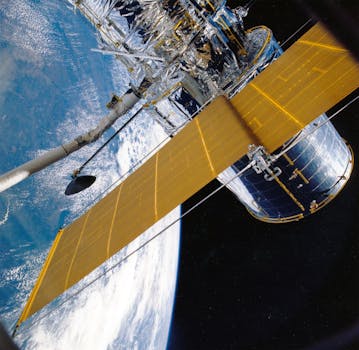The Rise of Mega-Constellations: Latest Updates in Satellite Telecommunications

The Rise of Mega-Constellations: Latest Updates in Satellite Telecommunications
The Rise of Mega-Constellations: Latest Updates in Satellite Telecommunications is a rapidly evolving field that has gained significant attention in recent years. The concept of mega-constellations refers to the launch of thousands of satellites into low Earth orbit (LEO) to provide global internet coverage and other telecommunications services. This development has the potential to revolutionize the way we communicate and access information, and several companies are already making significant progress in this area.
One of the key players in the development of mega-constellations is SpaceX, which has launched over 2,000 satellites into LEO as part of its Starlink constellation. The company plans to launch a total of 42,000 satellites into LEO, which will provide global internet coverage and other telecommunications services. Other companies, such as Amazon’s Kuiper Systems and OneWeb, are also launching their own mega-constellations, with plans to provide similar services.
Benefits and Challenges of Mega-Constellations
The development of mega-constellations has several benefits, including the provision of global internet coverage, improved telecommunications services, and increased access to information. However, there are also several challenges associated with this development, including the potential for space debris, interference with other satellites, and the need for significant investment in infrastructure and technology.
Despite these challenges, the development of mega-constellations is expected to have a significant impact on the field of satellite telecommunications. The provision of global internet coverage will enable people in remote and underserved areas to access information and communicate with others, which will have a positive impact on economic development and social equality. Additionally, the development of mega-constellations will drive innovation and investment in the field of space technology, which will have long-term benefits for the industry and society as a whole.
Latest Updates and Developments
There have been several recent updates and developments in the field of mega-constellations. In 2022, SpaceX launched its first batch of Starlink satellites into LEO, which marked a significant milestone in the development of the company’s mega-constellation. Other companies, such as Amazon’s Kuiper Systems and OneWeb, have also made significant progress in the development of their own mega-constellations.
In addition to the launch of new satellites, there have also been several recent developments in the field of space technology that will support the development of mega-constellations. For example, advancements in the development of reusable rockets and other launch technologies will make it easier and more cost-effective to launch large numbers of satellites into LEO. Additionally, the development of new materials and technologies, such as advanced propulsion systems and satellite components, will improve the performance and efficiency of satellites in mega-constellations.
Conclusion
In conclusion, the rise of mega-constellations is a rapidly evolving field that has the potential to revolutionize the way we communicate and access information. The development of mega-constellations will provide global internet coverage, improve telecommunications services, and drive innovation and investment in the field of space technology. While there are several challenges associated with this development, the benefits of mega-constellations are expected to have a significant and lasting impact on the field of satellite telecommunications and society as a whole.
